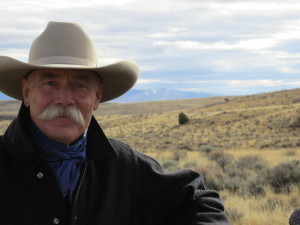 Randy Rieman fulfilled his childhood dream of becoming a horseman when, in his early 20’s he left the Midwest and traveled to Montana. With a keen willingness to work hard and an enthusiasm for learning, he connected with many fine horseman, including Bill and Tom Dorrance in California. For the past 30 years, he has honed his craft in California, New Mexico, Hawaii, and, of course, Montana, which he now calls home. Along the way, he’s also risen to the top as a rawhide braider and a cowboy poetry reciter. He travels nationally and internationally to share what he’s learned. Visit his website.
Randy Rieman fulfilled his childhood dream of becoming a horseman when, in his early 20’s he left the Midwest and traveled to Montana. With a keen willingness to work hard and an enthusiasm for learning, he connected with many fine horseman, including Bill and Tom Dorrance in California. For the past 30 years, he has honed his craft in California, New Mexico, Hawaii, and, of course, Montana, which he now calls home. Along the way, he’s also risen to the top as a rawhide braider and a cowboy poetry reciter. He travels nationally and internationally to share what he’s learned. Visit his website.
Register for Randy Rieman Clinic, September 24-26. Click here.
Here, Rieman discusses the need to balance what you read or watch with actual doing.
Read about his Dorrance memories.
Read about Randy, as a Renaissance Man.
Read additional Remuda Reader installments: Part I, Part II, Part III, Part IV.
Not a Remuda Reader? Click here.
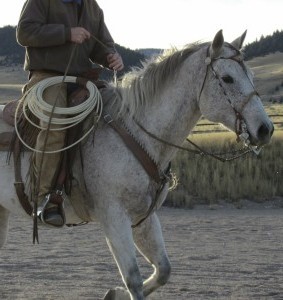 In this installment, Rieman discusses further the merits of time in the saddle, of thinking outside the box, and of seeing the bigger picture. What other horseman can relate writing, skiing, and sailing to riding?
In this installment, Rieman discusses further the merits of time in the saddle, of thinking outside the box, and of seeing the bigger picture. What other horseman can relate writing, skiing, and sailing to riding?
Randy Rieman:
In the movie Finding Forrester, Sean Connery is a brilliant writer. A young man asks him how to be a writer. “Punch the keys!” he says.
Writers write. They don’t talk about writing, they write. And if you’re gonna be a rider, you’ve got to ride. Go do something. I was talking to Joe Wolter the other day, and a gal at his clinic said, “I have such a hard time moving my horse’s feet.” Joe said, “That’s because you’ve worked on slowing him down his whole career. Now, he thinks that’s what he’s supposed to do. She said, “What do you do?” He said, “Well, one day a week I just go everywhere at a lope. Doesn’t matter where, I just go at a lope. If I’m going to the mailbox, I lope. If I’m going back home, I lope. If I’m going to get another horse, I lope.”
She said, “Wow, I never thought of that.”
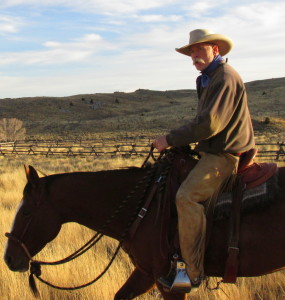 That’s not training so much as introducing them to something they can already do and giving them a purpose to do it. They get their focus on a task instead of on you all the time.
That’s not training so much as introducing them to something they can already do and giving them a purpose to do it. They get their focus on a task instead of on you all the time.
You see, it’s difficult to convince people to think outside the box in everything in life. But the more you realize that there’s way more outside the box than inside the box, then the more exciting it becomes to think outside the box.
I can’t tell you how many people I’ve talked with about initiating a turn with your inside leg, instead of pushing your horse around the turn from the outside. Because everybody pushes their horse around from the outside. Or a lot of people do.
Set up the horse’s drive train
But I say, think of a sailboat. If you’re gonna turn right, you tip the rudder, and the back end starts moving before the front end starts moving. Why not do the same thing? The drive train for that horse is in the back. Why not set the drive train up for the turn? The rest of the body will follow what that drive train is being asked to do. And it’s like a revelation. I can’t believe it. It’s so simple!
It works so well. The horse’s spine makes an arc in the direction of travel. Well, you can always stop the back end and bring the front end across. But you can’t always get them to stay fluid and correct if you’re trying to push them around the corner from the outside, because the attention gets tipped in the opposite direction of travel. They don’t step as freely, because they don’t see 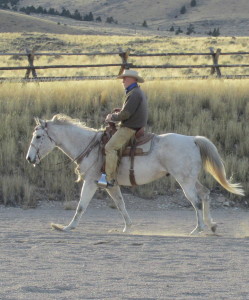 where they’re going. In essence, you have distracted them from what you want them to do.
where they’re going. In essence, you have distracted them from what you want them to do.
And it’s amazing how many people have never ever heard about that. They’ll say, “Like you do what? What do you mean, turn right with your right leg? I thought we were moving away from pressure?”
Well, sure enough, see you move that inside hind leg up and over, because you’ve put your right leg back here. That sets up the spine so the shoulder and the ribs have a place to turn to, because the hip’s now out of the way.
So those are little things. They are mechanical thing, nuts and bolts things.
If I’m going to initiate a turn in this circumstance what would I do? If I’m a downhill skier wanting to make a big sweeping turn, I’d do things one way. If I wanted to make a little quick turn I’d do something different.
How do I apply a skier’s smoothness to a turn? Well, if I get to looking in the opposite direction, then I lose my confidence and I lose my range of motion in the direction of travel. I want to keep it so simple that I don’t confuse my horse, don’t misdirect his attention, and don’t inhibit his body from being properly contoured for the direction of travel.
Those little things, they just make everything simpler.
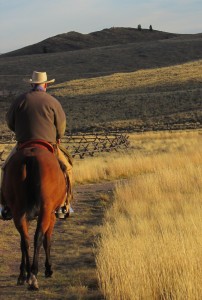
I like the skiing anology. Engage and tip the inside ski (leg) in the diredton ofthe turn
I watched Joe Wolters demonstrate initiating a turn with his inside leg in Utah and it made so much sense. The important thing is it makes so much sense to the horse. It’s made me more accurate with my feet and timing.